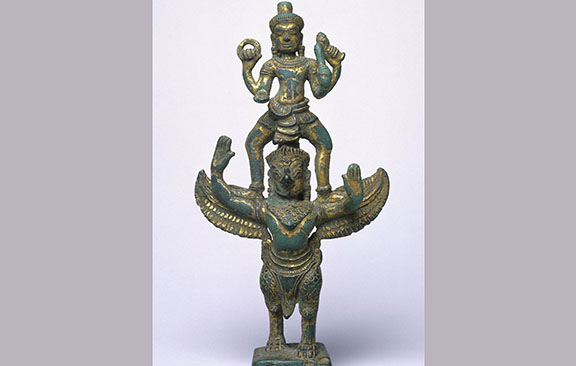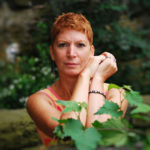 Garuda, the Eagle god as depicted in the Mahabharata, is the vehicle that carries Lord Vishnu. Vishnu is the deity representing preservation, sustainability or, in a more tangible way, Garuda is the vehicle that carries the True Self.
Garuda, the Eagle god as depicted in the Mahabharata, is the vehicle that carries Lord Vishnu. Vishnu is the deity representing preservation, sustainability or, in a more tangible way, Garuda is the vehicle that carries the True Self.
Garudasana, is a pose that requires balance, focus, and medial (internal) hip and shoulder rotation in order to “wrap” the arms and legs. This “wrapping,” balancing, and inward rotation pose is challenging for many Hatha Yoga students. As we wrap into ourselves with focus and confidence, we begin to ride on the wings of Garuda discovering the inner, True Self, the Atman; when expanding the backside of the body, one increases flexibility to the muscular groups that are associated with breathing, such as the rhomboid muscles and the intercostal muscles. When these muscles become more toned and flexible, breathing becomes more efficient. Prana, the manifestation of the vital energy, is the representation of Lord Vishnu—preservation and sustainability.
How to Teach Garudasana
This is a pose that can be practiced by working with just the arms or just the legs. If you are working with both the upper and lower extremities, in the full expression of the pose, you may choose to start first with the arms or first with the legs. Within the context of this article we will begin instruction with the arms first.

Be sure to instruct a thorough warm-up, focusing on the upper back, shoulders, hips and legs. After the warm-up, begin with the arms at shoulder level in front of the torso, bending them and crossing the right arm on top of the left, intertwining the forearms and wrists to connect the palms of the hands or the backs of the hands depending on what may be accessible. Note: the bottom arm hand, more than likely, will not be level with the top arm hand. If the shoulders and/or upper back are tight, students may simply bring the forearms towards one another and palms together, elbows about shoulder level.

Once the arms are in place, the legs can come into play; bending the knees and crossing or wrapping the left thigh over top of the right thigh and bringing the shin and foot around the back of the right calf or ankle.

This is the more challenging aspect of the asana and individual anatomy may compromise a “complete wrap.” The model demonstrates the possibility of using a block underneath the foot of the top leg if wrapping of the leg is not possible.
Whether the student comes into the full expression of the pose or chooses to practice the arm and leg variations separately, it is important to remind students of the principle of sthiram sukham (steady, comfortable), so they may feel more firmly grounded before attempting to balance. The pose can be an expression of both linear and expansive energy. The front of the body is rolling into the midline, while the sacrum and the space between the shoulder blades are wide and open. After finding one’s balance, the student could hinge forward and possibly touch the elbow to the top knee, which effectively brings more space to the backside of the body. Encourage your students to move inward, letting Garuda carry them—just as Lord Vishnu is carried by Garuda.
About the Teachers:
 Kali Morse, E-RYT 500, RPYT, C-IAYT, is director of the Teacher Training programs at the New York Integral Yoga Institute. Kali’s dedication and service to the art and science of Yoga spans four decades. She has taught Yoga in many settings including schools, colleges, hospitals, businesses, etc. She is certified to teach Integral Hatha Levels I, II, and III, Meditation, Raja Yoga, Prenatal and Postnatal Yoga, Children’s Yoga, and Therapeutic Yoga.
Kali Morse, E-RYT 500, RPYT, C-IAYT, is director of the Teacher Training programs at the New York Integral Yoga Institute. Kali’s dedication and service to the art and science of Yoga spans four decades. She has taught Yoga in many settings including schools, colleges, hospitals, businesses, etc. She is certified to teach Integral Hatha Levels I, II, and III, Meditation, Raja Yoga, Prenatal and Postnatal Yoga, Children’s Yoga, and Therapeutic Yoga.
 Rashmi Galliano, E-RYT 500, RPYT, is a certified Hatha II, Hatha III, Gentle, and Prenatal Integral Yoga teacher and has been teaching since 2006. She is one of Integral Yoga’s senior teacher trainers. Rashmi is also certified as a teacher of Prana Yoga with Jeff Migdow, M.D., through the Open Center in New York City; of Vinyasa Yoga with Stephanie Keach in Asheville, North Carolina; of Yoga Anatomy with Leslie Kaminoff at the Breathing Project in New York City; and of “Relax and Renew” Yoga through Judith Lasater. She has training in Reiki levels 1 and 2 from Tom Capshew.
Rashmi Galliano, E-RYT 500, RPYT, is a certified Hatha II, Hatha III, Gentle, and Prenatal Integral Yoga teacher and has been teaching since 2006. She is one of Integral Yoga’s senior teacher trainers. Rashmi is also certified as a teacher of Prana Yoga with Jeff Migdow, M.D., through the Open Center in New York City; of Vinyasa Yoga with Stephanie Keach in Asheville, North Carolina; of Yoga Anatomy with Leslie Kaminoff at the Breathing Project in New York City; and of “Relax and Renew” Yoga through Judith Lasater. She has training in Reiki levels 1 and 2 from Tom Capshew.
Disclaimer: We offer only information and no medical advice. You should consult a medical practitioner before starting any new exercise regime. This is particularly important if you are overweight, pregnant, nursing, regularly taking medications, or have any existing medical conditions. This website may not be tailored to your current physical and mental health. We accept no liability whatsoever for any damages arising from the use of this website.

